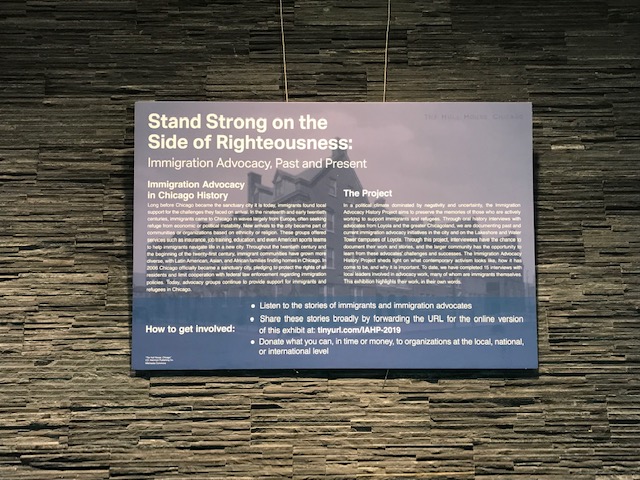archive
Immigration Advocacy History Project Launches Exhibit
The Immigration Advocacy History Project’s "Stand Strong on the Side of Righteousness: Immigration Advocacy, Past and Present” exhibit at the Damen Student Center is now open.
A coalition of history graduate students, including Nathan Ellstrand, Ella Wagner, Ina Cox, and Public History MA alum Stephen Petrie, started the Immigration Advocacy History Project in 2017 under the direction of Dr. Ben Johnson after the group was awarded a grant to conduct oral histories, an exhibit, and a guest speaker event. The project is designed to document both past and current immigration advocacy at Loyola and in the surrounding areas and to illuminate contemporary activism by understanding its roots, as well as to give participants a chance to have their work and stories documented. The project received a grant from the Student Innovation Fund, part of Loyola’s Plan 2020 to enhance student success, social justice, and partnerships with the Rogers Park/Edgewater communities.
Now, students and faculty can visit the story of Chicago based immigration advocacy as part of an exhibit. "Stand Strong on the Side of Righteousness: Immigration Advocacy, Past and Present” is located on the second floor of Damen Student Center now through April. If you are unable to attend the physical exhibit, graduate students Hannah Overstreet and Emily-Paige Taylor are developing a digital exhibit which will be online in April.
Co-chairs of the project have been Nathan Ellstrand and Kristin Jacobsen. Interviews of immigration advocates were conducted by Anna Claspy, Nathan Ellstrand, Kristin Jacobsen, Sean Jacobson, Emily Muszynski, and Stephen Petrie. These interviews will be archived under secure conditions at the Loyola University Archives for future research use. Additional support throughout the exhibit planning process, research, and design were Ina Cox, Ella Wagner, Anna Claspy, Damian Loma, Emily Muszynski, Sean Jacobson, Matt Labbe, Sebastian Wuepper, and Sophia Croll.
Co-chair Kristin Jacobsen recalls the project as “a very gratifying from a public history point of view. We talk about sharing authority, but I think here we are also sharing community. Some of the immigration advocates at the panel knew each other, for example, but some did not and were exchanging contact information. Several audience members came up afterwards to talk to the panelists and exchange ideas. It’s been very exciting. I think that by doing the project, our group also has become immigration advocates in the sense of bringing attention to the issue. I feel a part of this community of advocates now.”.jpg)
